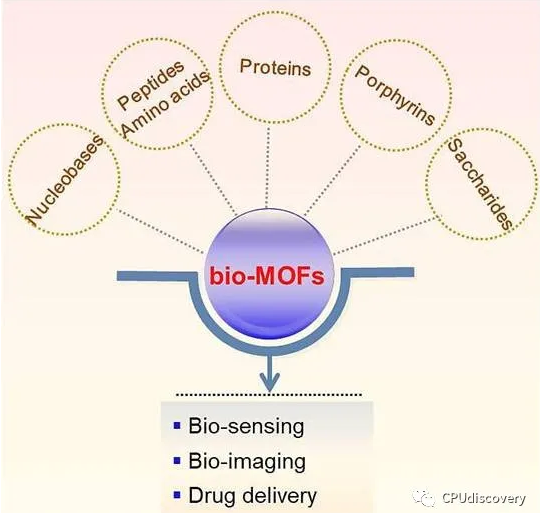Nanoscale Adv│MOFs review: Research progress of bio-metal-organic frameworks in the fields of biosensing, imaging and disease treatment
In recent years, metal-organic frameworks (MOFs) with good biocompatibility and functions have received extensive attention in the fields of biosensing, imaging and disease treatment. Organic ligands directly affect the biomedical applications of metal-organic frameworks (especially in terms of biocompatibility), so strict screening of organic ligands is very necessary. Endogenous biomolecules, including biological ligands such as nucleobases, amino acids, peptides, proteins, porphyrins, and carbohydrates, can be used as the framework for the construction of MOFs and can significantly increase the biocompatibility of materials (Figure 1). The combination of MOFs and biomolecules involves many modes, such as guest molecule loading, surface modification or directly as organic ligands to construct MOFs. Among them, MOFs formed by the coordination of biological endogenous molecules directly with metal ions are called bio-metal-organic frameworks (bio-MOFs). These biological ligands coordinate with different metal centers in different ways, thus forming the structural diversity of bio-MOFs.

Figure 1. Application of bio-MOFs in the fields of biosensing, imaging and disease treatment. Recently, Professor Ding Ya and Associate Professor Wang Huaisong of the School of Pharmacy of China Pharmaceutical University were invited to publish a review article on Nanoscale Advances. Focusing on the currently extensively studied bio-MOFs, the relevant applications of bio-MOFs constructed by endogenous biomolecules in biosensing, bioimaging, and disease treatment are discussed. This work outlines the design and biomedical applications of bio-MOFs based on nucleobases, amino acids, peptides, proteins, porphyrins, carbohydrates and other biomolecules as ligands in recent years, and discusses the preparation and application of bio-MOFs. Problems and challenges in biomedical applications. First of all, the interaction between metal ions and bioligands needs to be studied more systematically to provide a reasonable principle system for the design of bio-MOFs. Secondly, it is necessary to develop a simple, controllable, cost-effective preparation method, and to study the influence of solvents, temperature, pH, etc. on material synthesis to ensure that bio-MOFs have suitable size, uniform shape and processability. Then, the thermal stability, chemical stability and water stability of bio-MOFs still need to be strengthened, otherwise it will limit its development in biological applications. In addition, the study of the interaction between bio-MOFs and cells will help further imaging and treatment systems. After Bio-MOFs actively or passively target tumor cells, they can exert therapeutic effects and be degraded without affecting normal cells. Therefore, bio-MOFs with good biocompatibility and low toxicity will have great potential in biomedical applications. Finally, the physiological processes of bio-MOFs in the body (including biological absorption, distribution, transformation, metabolism and excretion) need to be studied in depth. In short, bio-MOFs will become a material with excellent biocompatibility and functions, and is expected to be applied in the future biomedical field (Nanoscale Adv., 2020, 2, 3788-3797.). Writer: Wang Yihui Original link: https://pubs.rsc.org/en/content/articlelanding/2020/na/d0na00557f#!divAbstractDOI: 10.1039/d0na00557f
Information source: WYH CPUdiscovery
This information is from the Internet for academic exchanges. If there is any infringement, please contact us and delete it immediately

Figure 1. Application of bio-MOFs in the fields of biosensing, imaging and disease treatment. Recently, Professor Ding Ya and Associate Professor Wang Huaisong of the School of Pharmacy of China Pharmaceutical University were invited to publish a review article on Nanoscale Advances. Focusing on the currently extensively studied bio-MOFs, the relevant applications of bio-MOFs constructed by endogenous biomolecules in biosensing, bioimaging, and disease treatment are discussed. This work outlines the design and biomedical applications of bio-MOFs based on nucleobases, amino acids, peptides, proteins, porphyrins, carbohydrates and other biomolecules as ligands in recent years, and discusses the preparation and application of bio-MOFs. Problems and challenges in biomedical applications. First of all, the interaction between metal ions and bioligands needs to be studied more systematically to provide a reasonable principle system for the design of bio-MOFs. Secondly, it is necessary to develop a simple, controllable, cost-effective preparation method, and to study the influence of solvents, temperature, pH, etc. on material synthesis to ensure that bio-MOFs have suitable size, uniform shape and processability. Then, the thermal stability, chemical stability and water stability of bio-MOFs still need to be strengthened, otherwise it will limit its development in biological applications. In addition, the study of the interaction between bio-MOFs and cells will help further imaging and treatment systems. After Bio-MOFs actively or passively target tumor cells, they can exert therapeutic effects and be degraded without affecting normal cells. Therefore, bio-MOFs with good biocompatibility and low toxicity will have great potential in biomedical applications. Finally, the physiological processes of bio-MOFs in the body (including biological absorption, distribution, transformation, metabolism and excretion) need to be studied in depth. In short, bio-MOFs will become a material with excellent biocompatibility and functions, and is expected to be applied in the future biomedical field (Nanoscale Adv., 2020, 2, 3788-3797.). Writer: Wang Yihui Original link: https://pubs.rsc.org/en/content/articlelanding/2020/na/d0na00557f#!divAbstractDOI: 10.1039/d0na00557f
Information source: WYH CPUdiscovery
This information is from the Internet for academic exchanges. If there is any infringement, please contact us and delete it immediately
+86-18915413828(WhatsApp&WeChat)
Previous: Ruiping Zhang/Pu Kanyi


